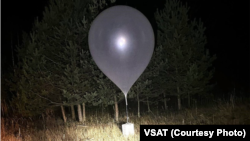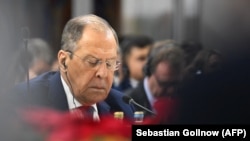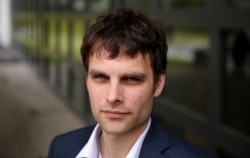
Welcome to Wider Europe, RFE/RL's newsletter focusing on the key issues concerning the European Union, NATO, and other institutions and their relationships with the Western Balkans and Europe's Eastern neighborhoods.
I'm RFE/RL Europe Editor Rikard Jozwiak, and this week I am drilling down on two issues: hitting Belarus's balloons and EU views on Montenegro and other accession hopefuls.
Briefing #1: Brussels Preparing Belarus Sanctions Over Balloon Incursions
What You Need To Know: The European Union is finally moving closer to sanctioning Belarus for the release of weather balloons over Lithuania in recent months.
These airspace violations have caused the EU member state to shut its largest airports several times, and in November it moved to temporarily seal its border with its southeastern neighbor.
According to Lithuanian officials who spoke to RFE/RL on condition of anonymity, a total of 315 unauthorized balloons have entered the country from Belarus since June, peaking in October with 71 airspace incursions.
Able to easily reach high altitudes, thereby making it harder for them to be spotted by radar, most of the balloons are used for smuggling knockoff Belarusian-made cigarettes. The balloons can also "double" as sabotage tools by forcing the closure of airports for safety reasons.
Between October and December, the two biggest Lithuanian airports -- in the capital, Vilnius, and in the central city of Kaunas -- had to halt operations 15 times, affecting over 320 flights and more than 45,000 passengers.
An incident involving one balloon resulted in Vilnius airport being shut down for nearly 12 hours in early December.
Lithuania brought the issue to the attention of Brussels in late October, and the European Union's foreign policy chief, Kaja Kallas, issued a statement condemning Belarus's "persistent and provocative actions against the EU and its member states"
Deep Background: No Brussels sanctions were issued immediately, notably as Vilnius didn't press the EU to go down that route at first.
Instead, Lithuania attempted another move: shutting the 700-kilometer border with its neighbor.
On October 29, all crossings to Belarus were essentially closed for regular traffic, with exemptions only for transit to the Russian exclave of Kaliningrad as well as for diplomats, European Union and NATO citizens, and European haulers returning from Belarus to the EU.
When the number of balloons decreased somewhat in November, Lithuania decided to re-open the border again on November 19.
Lithuanian diplomats told RFE/RL off the record that this move was a "sign of goodwill" to see if Minsk would stop the balloons.
It didn't really work as Vilnius airport has once again been forced to shut down twice a week on average since then. According to Lithuanian diplomats, the balloons now appear to be specifically targeting the country's main international airport and connection to the outside world.
Drilling Down:
- On top of that, roughly 1,000 Lithuanian-registered trucks have been stranded on the Belarusian side of the border since its closure. Vilnius says that the trucks have been ordered to move to dedicated parking lots, with a daily charge of 120 euros ($140) per truck and any failure to pay resulting in their being confiscated.
- At the end of November, Lithuanian Foreign Minister Kestutis Budrys sent a letter to Kallas, seen by RFE/RL, asking the EU for help in getting these trucks back. The EU's power is rather limited as diplomatic relations with Minsk have been cut to a minimum since the crackdown that ensued following the Belarusian presidential election in 2020, which was widely condemned as being rigged.
- But Brussels has at least one tool and that will be used imminently: an expansion of the EU's sanctions regime on Belarus to include the possibility of targeting those who send balloons into Lithuania.
- The EU has long had sanctions in place against strongman Aleksandr Lukashensko's regime. However, these affect people and companies involved in human rights violations such as repression of the opposition and civil society, officials in Minsk who have backed Russia's war on Ukraine, or those involved in the "instrumentalization of migrants," whereby Belarus has been accused of moving African and Asian migrants to the European Union's borders to destabilize neighboring EU countries.
- The proposal, seen by RFE/RL, would allow the EU to sanction people and organizations that threaten "the sovereignty or independence of one or several of its Member States." It does so by covering anyone involved in "planning, directing, engaging in, directly or indirectly, supporting, or otherwise facilitating any actions targeted at the functioning of democratic institutions, economic activities or services of public interest." According to the draft text, such actions include "unauthorized entry into the territory of a Member State, including its airspace," as well as "the disruption of the functioning of critical infrastructure."
- Expected to be approved by all EU member states before Christmas, this measure would allow Lithuania (and others) to start blacklisting more Belarusians.
- But it is not the only response that the Baltic country has in mind. Vilnius has also shared other proposed restrictive measures with Brussels that it wants to impose on Minsk going forward. These include a full transaction ban on 10 Belarusian banks, targeting nitrogen fertilizers on top of already sanctioned Belarusian potash, and slapping an EU import ban on Belarusian rapeseed oil and salt.
Briefing #2: EU Member States Have Their Say On Enlargement
What You Need To Know: After the European Commission published its annual enlargement report on November 4, giving thorough assessments of EU hopefuls Albania, Bosnia-Herzegovina, Georgia, Kosovo, Moldova, Montenegro, North Macedonia, Serbia, Turkey, and Ukraine, it is now up to the 27 EU member states to have their say by adopting so-called EU enlargement conclusions on December 16.
As this document needs to be adopted unanimously, it is often less critical than the commission equivalent -- and much shorter.
An advanced draft, seen by RFE/RL, appears to follow the logic of the commission's conclusions: Albania, Moldova, Montenegro, and Ukraine are considered the current frontrunners, and the EU is looking to add at least one to its ranks before the end of the decade.
Deep Background: The most obvious hint in the document relates to Montenegro and its progress toward membership.
Not surprisingly two key points are in brackets, meaning EU member states haven't agreed on them yet.
One states that the country "has advanced further in its accession negotiations and that 12 negotiating chapters now have been provisionally closed." The number 12 is still in brackets. This is because Podgorica has so far only managed to close seven of the 33 policy chapters needed to join the bloc. There is still hope in Brussels, however, that up to five more can be concluded before the Christmas holidays even though diplomats whom RFE/RL spoke to suggest the final number may be lower.
The other hint in the document is that the small Western Balkan country is inching closer to becoming member state No. 28 rather soon.
Another bracketed sentence states that "the Council decides that the Ad hoc Working Party on Drafting the Accession Treaty with Montenegro will be established in 2025."
The council, where EU member states meet in Brussels, is full of various working groups in which diplomats deal with all sorts of policy matters from an early stage.
The fact that a group tasked with drafting the accession treaty with Montenegro is about to be set up is a sign that things are getting serious. Drawing up such treaties follows immediately after the closure of all negotiation chapters and represents the final political act before actual membership.
But it isn't all encouragement for the Balkan country. Some clear "homework" on what is needed to complete the "final stretch" to Brussels is also spelled out.
The text states that Montenegro must improve its administrative capacity and electoral legislation, particularly insofar as it concerns adhering to EU standards on the financing of political parties and electoral campaigns.
The big issue, however, is corruption, with the document cautioning that "the number of final convictions in high-level corruption cases remains low." It also "stresses the need for Montenegro to improve its track record with respect to investigations and prosecutions in high-level corruption and organized crime cases, ensuring final convictions, dissuasive penalties, asset seizures and confiscations."
Drilling Down:
- Not surprisingly, fighting corruption is the leitmotif for all of the front-runners. There is no direct mention of the recent Ukrainian scandal that forced President Volodymyr Zelenskyy's right-hand man and chief of staff, Andriy Yermak, to step down in late November. However, the work of the National Anti-Corruption Bureau of Ukraine and the Specialized Anti-Corruption Prosecutor's Office, which helped bring down Yermak, is applauded: The council positively notes the results delivered by the agencies in 2025, including a significant number of investigations, notably in high-level corruption cases. It strongly encourages Ukraine to pursue efforts to "further improve its track record and capacities in this domain."
- The enlargement report also warns Ukrainian politicians not to try to undermine the two institutions, something Zelenskyy attempted over the summer before making a swift U-turn amid a public outcry. The document states Brussels "will remain vigilant on this matter and stresses the need to ensure that, in the future, no legal or political interference should impact the work of these institutions."
- For Moldova, the text is complimentary about its fight against money-laundering and the push for what is known as "de-oligarchization." Neither Moldova nor Ukraine, however, will move forward on their EU membership path this year. Hungary has made it clear it won't green-light any opening of chapters with Kyiv, and Moldova is still not pushing to be separated from Ukraine.
- Instead, most EU capitals have resigned themselves to waiting until the Hungarian parliamentary elections in April for any change of stance from Budapest. The text offers very little in terms of what will happen next to both Kyiv and Chisinau, with the text simply stating that that the council looks forward to the opening of the fundamentals cluster with both candidates, "as soon as the conditions are met."
- For Albania, which recently managed to open all 33 chapters in 13 months (a record time for an EU candidate country), there is no indication as to when it can actually can start closing files, which is harder.
- While fighting corruption is also a key condition for Albania, the document also highlights the need to improve the media landscape in the country by increasing the transparency of media ownership, ensuring the decriminalization of defamation, and strengthening civil society in general.
- For the other EU hopefuls, the text is largely a mixed bag apart from Georgia, which has been thoroughly criticized for its "democratic backsliding" in recent years. While not calling the country "a candidate in name only" as the European Commission did in its report, the council says "the actions taken by the Georgian authorities fall short of the EU's expectations of a candidate country," and "Georgia's EU accession process has effectively come to a standstill until the authorities demonstrate resolute commitment to reverse course and return to the EU accession path."
Looking Ahead
European Affairs ministers from most EU member states are expected to convene in the western Ukrainian city of Lviv on December 10-11 for an informal general affairs council.
The idea is to show support for Ukraine and encourage the country to continue the reforms needed to one day become an EU member.
Ukrainian Deputy Prime Minister Taras Kachka will give a presentation on how Kyiv has been faring so far, notably in rule of law. But he is also expected to push his EU counterparts to be ready to begin proper accession talks in earnest next year.
That's all for this week!
Feel free to reach out to me on any of these issues on X @RikardJozwiak, or on e-mail at jozwiakr@rferl.org.
Until next time,
Rikard Jozwiak
If you enjoyed this briefing and don't want to miss the next edition subscribe here.






